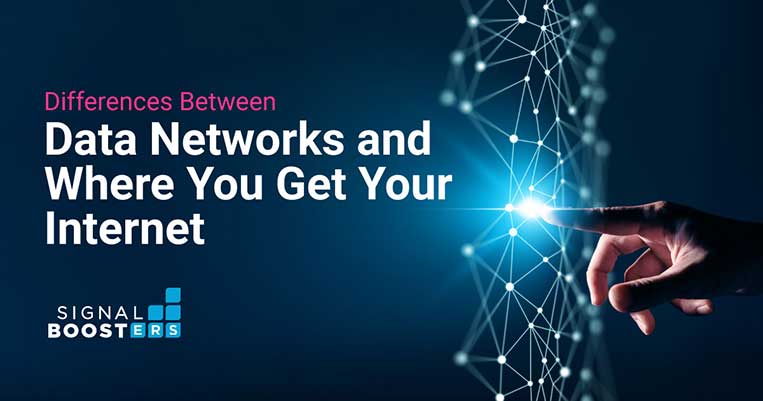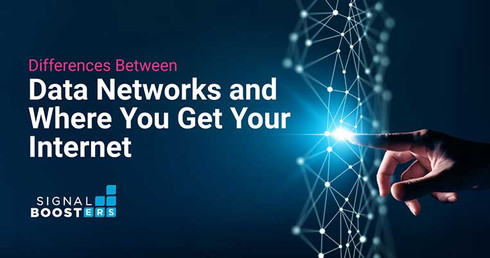6 Types of Networks and Where You Get Your Internet

Where Does My Internet Access Come From?
Internet access has become such a central tool in our everyday lives that it’s easy to forget how new this technology really is. It was not so long ago that dial-up internet burst onto the scene, revolutionizing the way we communicate with each other, and providing access to a worldwide web of information. Today, the wonders of the internet can be accessed in a variety of ways, making the never-ending dial-up tone a far-off memory for those lucky enough to connect to reliable high-speed internet service. Thankfully, we have options for all types of internet networks and types of internet… and signal boosters for every situation.
Take advantage of our system design and installation services. Learn more or call us for a free consultation: 1-800-969-8189.
1. Dial-up Internet (up to 56 kbps)
While most modern households have moved on from this dated technology, it is still a somewhat viable internet option for those with limited resources. Remote and rural areas may resort to dial-up internet out of necessity, though the snail’s pace of such connections makes it difficult to complete many necessary functions. Even the best dial-up service is incredibly slow compared to current standards, and does not qualify as high-speed internet.
Dial-up connections utilize existing phone lines to connect to an internet service provider, using a dial-up modem. This ties up the phone line so users can either make phone calls OR connect to the internet, but never both at the same time.
2. Satellite Internet (12-100 Mbps)
Like dial-up, satellite internet is a necessary option for many subscribers in rural and remote areas, where the infrastructure needed for more conventional high-speed internet services are out of range.
Satellite internet service uses a home satellite dish to connect to a satellite in the Earth’s atmosphere, thousands of miles above. If that sounds like a long way for your requests to travel, it is, and the speed of your Wi-Fi internet service is proof. While satellite internet is technically considered high-speed, it is the slowest of its kind, making tasks like video chat and streaming difficult.
It’s also expensive and particularly susceptible to disruptions caused by weather and other natural phenomena. A lot can happen between your living room and outer space…
3. DSL (Digital Subscriber Line) Internet (3-115 Mbps)
Like dial-up, DSL uses telephone lines to connect users to the internet. Unlike dial-up however, DSL uses broadband technology to travel along different internal wires than dial-up, enabling much faster speeds while freeing up the line for simultaneous phone calls.
Available through most telephone companies, DSL is the slowest of the new broadband technologies, but it is also the most widely available and reliable service in the world. Actual speed depends on your distance from the internet service provider, though on the upside, DSL speed is not affected by congestion from multiple users.
4. Cable Internet (10-500 Mbps)
Comparable to DSL’s service, cable internet uses broadband technology to transmit high-speed internet through the same coaxial cables that providers use for cable television services. Depending on your location, cable internet speeds are usually similar to DSL, though some areas are able to reach much faster speeds. Cable internet service is available through most cable TV providers.
Unlike DSL, cable internet is subject to congestion from multiple users, typically slowing down during peak hours — like those streaming-heavy evenings after work. While cable internet is widely available and fairly affordable, it does require existing cable connections, which can be hard to come by for more rural or remote locations.
5. Fiber Internet (Up to 10,000 Mbps)
The newest in broadband internet technology, fiber-optic internet boasts the highest speeds available. Fiber-optic cables contain filaments of glass or plastic, which use light pulses to transmit large amounts of information over long distances at the highest speeds. Unlike previous broadband services, fiber-optic upload speeds mirror its download speeds, which are typically quite disparate across DSL and cable transmissions. Fiber internet is also immune to the slow-down issues that other internet services experience.
Because this technology is so new — and relies on a wholly independent infrastructure — fiber-optic internet service is both expensive and hard to come by. As companies move to adopt this newer, faster service, it is making its way to more cities — though it must be built from the ground up, since unlike DSL or cable, fiber internet does not utilize existing lines of service.
6. Cellular Network Internet (Up to 300 Mbps)
Ah, that seemingly invisible internet service that magically appears on your smartphone. While 3G, 4G, and 5G enabled devices are able to access the internet simply by toggling the cellular data function, it is also possible to harness this service for other WiFi-enabled devices in your home or office. Bypassing traditional Wi-Fi service is simple, and with a cell phone signal booster, your connection can be even better.
While personal hotspots make it easy to share your cellular data with other devices, a cellular router can provide this same service without draining your cell phone battery. Cellular routers are great on-the-go, since most wireless service providers cover wide areas. And when you move outside of these coverage areas, or just need a boost to your existing signal, a cell phone signal booster can work wonders.
Where distance, congestion, and a lack of infrastructure can get in the way of download speeds, cellular service can fill the void left by other internet service providers. Cell signal boosters work everywhere, whether it’s a vehicle, home, or office — pulling in the nearest signal, amplifying it, then rebroadcasting that newly boosted, crystal clear connection to all of your devices.
It might not be the cheapest option, but pairing a cellular router with a signal booster provides the best internet for cell phones and data-driven devices, without all the wires.
Contact Us
We’re here to assist with any issues you might be experiencing with poor cell service. Contact us today, or call us at 1-800-470-6777.
Interested in Learning More? Check Out Our Cellular Info Hub / WiFi Info Hub





